Tuesday, 21 February 2023
MaX develops advanced simulation software for powerful supercomputers
European research centres and companies leading the development of supercomputing hardware and simulation software re-join forces in the third phase of the MaX European Centre of Excellence, funded by the European Union (grant agreement no. 101093374) and supported by the Euro HPC Joint Undertaking (EuroHPC JU) and its member states. The MaX (“MAterials design at the eXascale”) Centre will continue to drive the evolution of materials science simulation software towards a new era of extremely increased computation power. This will open new opportunities for designing and testing materials for applications in crucial fields, such as clean energy, new IT technologies, and manufacturing as a whole.

In January 2023 the European High Performance Computing Joint Undertaking (EuroHPC JU) launched 10 Centres of Excellence (CoEs) that will develop and scale up existing computing codes towards exascale performance in the next four years. The MaX (“MAterials design at the eXascale”) European Centre of Excellence, dedicated to the development of advanced software for materials modelling and simulations, has renewed its funding from the European Union (grant agreement no. 101093374), entering a promising third phase of the project. After its official start on 1 January 2023, MaX is publicly launched with a kick-off meeting on 21-22 February 2023 at the Italian National Research Council (CNR-NANO) in Modena (Italy). Prof. Elisa Molinari, from CNR-NANO and Unimore, University of Modena and Reggio Emilia (Italy), is the project coordinator.
In a time when supercomputers and the so-called High Performance Computing (HPC) offer unprecedented calculation and data processing power, MaX brings together 16 renowned European research centres, supercomputing centres, universities and private companies operating in this field to develop the tools required to take advantage of such powerful hardware. This will allow simulating, studying and designing novel materials for a variety of applications, spanning energy, sustainability, information and communication technologies, biomedicine and diagnostics, and much more.
Materials Science is at the core of most of the technologies that characterise our current society and those that will shape our future. The discovery of materials and, even more, the possibility to design and synthesise new ones having specific characteristics, are crucial for technological progress and to overcome the most critical challenges we are facing nowadays –in sustainability, environmental protection, energy security, health, etc.
Accurate theoretical modelling and reliable computer simulations are extremely important in materials science, as they allow researchers to study fundamental phenomena of matter and then use this knowledge to design new materials with optimal properties for specific applications. MaX uses a quantum mechanical description of matter to develop codes that prove to be extremely powerful tools for these purposes.
Increasing opportunities are provided by the ever-progressing High Performance Computing hardware, which provides much higher computational capacity than traditional computing and, therefore, leads to results in less time and at a lower cost. This is what is called the “exascale” computing revolution, referring to the number of operations that the most advanced supercomputers can perform in one second (specifically, a billion billion or 1018). Together with hardware, simulation software codes are sprouting, growing and adapting to take advantage of this computing power.
MaX focuses not only on developing new open-source simulation software, but also, in particular in this third phase, on adapting the most broadly used codes in electronic structure to run on new HPC exascale platforms –or, in other words, current and future super-powerful supercomputers. In addition, the software is being structured in such a fashion that it can work on multiple computing architectures from different vendors.
Since the consortium that will carry out the project over the next four years includes both software developers and HPC hardware experts, as well as the main European companies and actors involved in the development of supercomputing technologies towards exascale, a cross-feed of information and expertise will generate a virtuous circle in which programmes will adapt to the computer architectures and, conversely, new powerful hardware will be shaped accordingly to the needs of materials scientists.
While leading this collaborative effort for the transition of materials science and simulation towards the exascale era, MaX will also strongly engage in training, outreach, and educational activities to enlarge and strengthen the involved community, in close coordination with the European HPC ecosystem.
The ICN2, a CERCA research centre and a member of BIST located within the UAB campus premises, is one of the research institutes leading some of the scientific activities of the project –with the participation of the Theory and Simulation Group, led by Prof. Pablo Ordejón–, as well as the work package devoted to Dissemination, Communication and Exploitation –managed by the ICN2 Marketing and Communication Department.
For more information about Centers of Excellence, read the EuroHPC JU press release:
Kick-off of 10 Centres of Excellence in HPC to support the transition towards exascale
Background image Credits: Image generated with AI. Full image. Midjourney prompt: Conceptual representation of exascale computing power. Beautiful workflows of data are filling a vast space, interacting with each other to produce applications on energy, medicine and sustainability. Red glow style.

